Small Orange Bugs (With Pictures) – Identification Guide
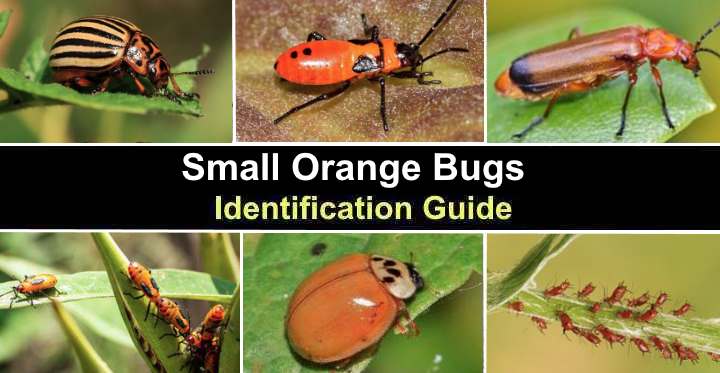
Small orange bugs can be a pesky nuisance in your home or garden. The tiny tangerine-colored pests could be harmless bugs that you can ignore. Or the small, orange-colored bugs in the house, like orange aphids, boxelder bugs, or Asian lady beetles, could infest your plants. They may even give you a painful bite. Identifying the species of small orange bugs you discovered will help you know how to deal with them.
Thankfully, finding orange bugs in your house or yard is not as common as discovering small black bugs. However, you should act swiftly if you come across orange bugs. You don’t want to wait until they multiply into large numbers before trying to get rid of them.
But before acting, it’s vital to identify the orange insect species. This is important because different types of insects require different treatments. Additionally, some orange bugs are beneficial, while others need eradicating.
Have you encountered small orange bugs and want to know what to do with them? If so, please continue reading. This article contains helpful information on identifying species of orange bugs commonly found in homes and around properties.
How to Identify Small Orange Bugs
Small orange bugs are identified by their body shape, if they have a hard shell, fly, and any distinguishing markings. In addition, the orange bug’s habitat can help reveal its identity. For example, some orange bugs only appear in homes at certain times of the year. Other orange-colored bugs only live on plants.
It’s challenging to identify an orange bug species correctly. The orange-colored insects can be so tiny you must examine them under a magnifying lens. Also, some orange bugs may appear a darker reddish-orange, whereas others have bright orange bodies covered in black spots.
From a scientific perspective, orange bugs are identified as insects in the order Hemiptera. These tiny insects are distinguished from other species because they have an arrangement of piercing-sucking mouthparts. Therefore, many species of bugs are common plant pests — the orange bugs bite into plant tissue and suck plant juice.
Although many people refer to most pesky insects as bugs, not all are bugs in the true sense of the word. This article mainly discusses orange bugs that are in the order Hemiptera.
Tiny Orange Bugs
Tiny orange bugs are some of the hardest to identify. Many grow less than 0.15” (4 mm) long and are only noticeable when flying or congregating in large groups. However, in some cases, the first sign of orange bugs is when large numbers of them damage plant health.
Orange Aphids (Aphidoidea)
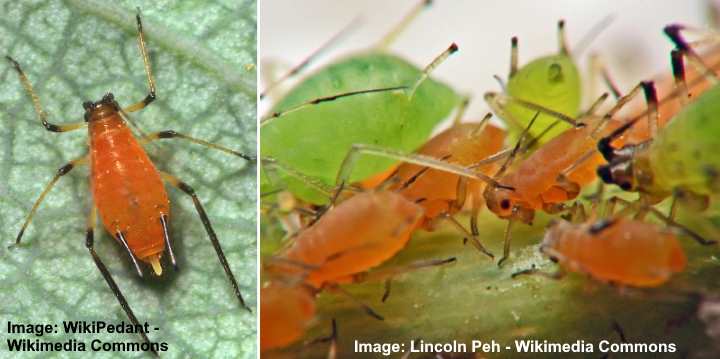
Orange aphids are tiny insects that can be destructive to plants in large numbers
Orange aphids are one of the tiniest orange bugs you’ll find. The little flying insects are characterized by an orange pear-shaped body, six black legs, a pair of black antennae, and two cornicles (tail pipes) at the end of their abdomen. Orange aphids measure 0.78” to 0.15” (2 – 4 mm) long.
Due to their tiny size, orange aphids are difficult to identify on plants. However, recognizing the signs of an infestation of orange-colored aphids is crucial. According to some estimates, aphids of any color are the most destructive insect pests on plants. Therefore, it’s essential to act quickly upon discovering orange-bodied aphids on plants.
What are the signs of orange aphids? Because the minuscule, tear-shaped orange pests are hard to see, you should check plants for damage. Orange aphids bite plant tissue, sucking the juices and spreading disease. Here are some tell-tale signs of aphid plant damage:
- Weak plant growth
- Twisted or curled leaves that turn yellow
- Dead shoots
- A sticky yellowish substance called honeydew on plant stems
- Black sooty mold
If there is a heavy infestation, you will see tiny orange bugs in groups on plant stems and leaves.
To get rid of orange aphids, isolate the plants from other houseplants if possible. Then use a natural neem oil solution and spray the plant foliage and stems every seven days to kill the nuisance pests. Neem oil interferes with the aphid life cycle and will eventually eradicate them.
If you have spotted yellow bugs on plants, these could indicate an issue with yellow aphids.
Small orange bug identification
Orange aphids are identified by their tiny tear-shaped orange bodies with a pair of tail-like projections at the rear of their abdomen. Some orange aphids have wings and can fly.
Small Orange Bugs
Small orange bugs are nuisance pests like assassin bugs, firebugs, orange seed bugs, or leaf-footed bugs. These pale to dark orange insects can have long, slender bodies, or they may have flattened shield-shaped bodies. You can identify the orange bugs by their distinctive markings, size, and body shape.
Milkweed Assassin Bug (Zelus longipes)
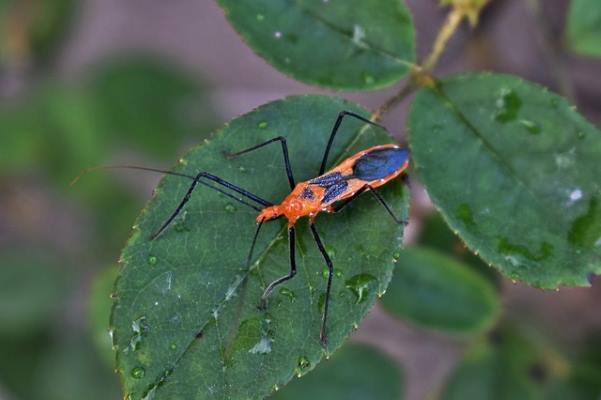
Milkweed assassin bug can be identified by its distinctive orange-reddish and black colored body, very long antennae and legs
The milkweed assassin bug is a slender brightly-colored orange insect with a jet-black patch on its abdomen. The orange bugs have long, spindly black legs and extra-long antennae. In addition, the orange assassin bug has a distinctively elongated body and tiny orange head. The black and orange bugs measure 0.5” (12.7 mm) long.
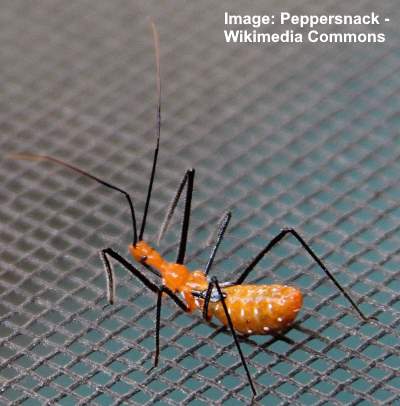
Milkweed assassin nymph
The native habitat of the milkweed assassin bug is gardens and grassy landscapes in North America. This orange bug is considered a beneficial insect because it preys on mosquitoes and caterpillars. As its name suggests, the bug waits for its prey before pouncing on it and using its mouthpiece to kill and devour its meal.
Although not aggressive, the milkweed assassin bug can bite if you handle it.
Small orange bug identification
The milkweed assassin bug has distinctive black marks on its bright orange slender abdomen.
Leaf-Footed Bug (Spartocera fusca)
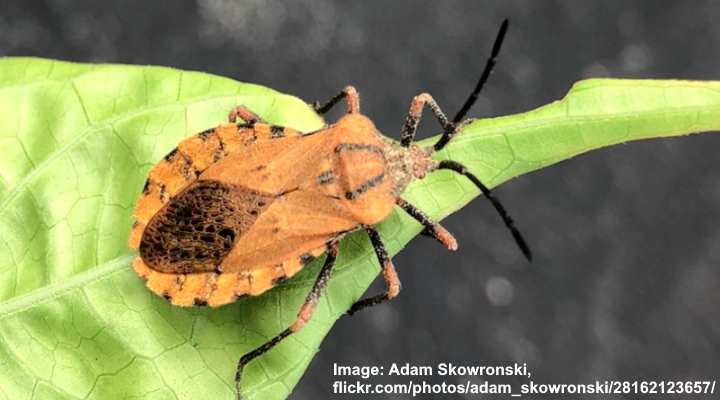
The leaf-footed bug has a flattened body and can be pale or dark orange with a black marking on its back
The leaf-footed bug is a pale yellowish-orange to deep, orange-colored bug with a distinctive flattened oval body. The distinguishing feature of this yellowish-orange leaf-feeding insect are black stripes around the margins of its abdomen. Additionally, there is an oval brownish-black mark on its back. However, there is color variation in the species.
The orange leaf-footed bug measures 0.78” to 0.94” (20 – 24 mm) long. You will often find the oval orange bug feeding on potato plant leaves and other plant foliage from the nightshade family. The black and pale orange bug isn’t a significant garden pest despite feeding on crops.
Small orange bug identification
The leaf-footed bug is identified by its yellowish-orange or darker orange, broadly oval, flattened body with bold black markings. The common garden bug also has orange and black legs.
Firebug (Pyrrhocoris apterus)
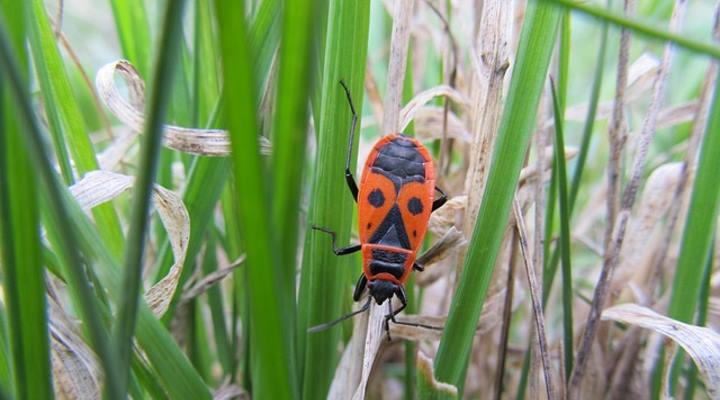
Firebugs can be easily identified by their orange-red body with black round spots and triangular markings
The orange-colored firebug is an eye-catching insect due to its brightly colored orange abdomen, with two black dots and distinctive black patterns. In addition, this orange and black bug has black legs and a pair of black angled antennae. Firebugs measure 0.4” (10 mm) long and commonly feed on mallow and lime trees.
Firebugs are easy to spot in the yard due to their vibrant reddish-orange color and black markings. Although the small orange bugs are harmless, they can find their way into houses in the fall. It’s best not to squash them because they emit a foul odor and can leave a dark red stain on fabrics.
Small orange bug identification
The firebug has a flattened bright reddish-orange oval body with triangular and rounded black patterns on its abdomen.
Orange Seed Bugs (Spilostethus pandurus)

The small orange seed bug is identified by its orange and black body and a brown patch on its tail end
The orange seed bug is a type of ground bug with bright orange and black coloration. Identifying features of this orange-colored insect are two wavy bands on its thorax and an ‘X’ shaped pattern on its abdomen. In addition, there is a black band traversing it back, and it’s got a brown tail end.
The orange seed bug measures 0.51” to 0.60” (13 – 15 mm) long. The bug’s name comes from its bright orange color and habit of feeding on the seeds of many plants. Although it’s not a significant pest in gardens, the orange seed bug can attack peanut, tobacco, and sunflower plants.
Small orange bug identification
The orange seed bug has recognizable black wavy bands on a brightly-colored orange elongated oval abdomen.
Orange Assassin Bug (Pselliopus barberi)
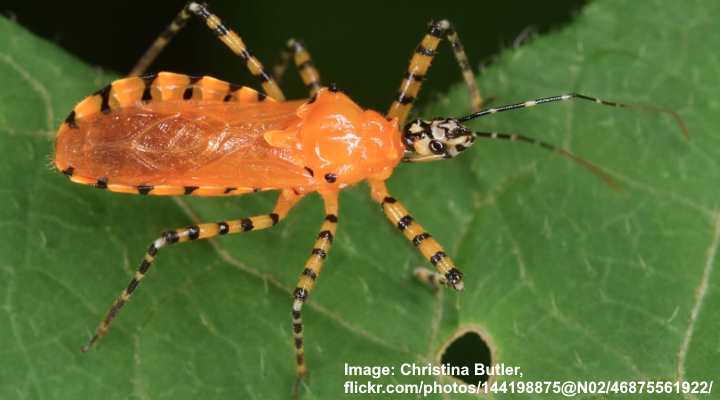
The orange assassin bug has an oval body with black and orange striped legs
The orange assassin bug is a pale golden-orange bug with a flattened oval abdomen and distinctive, black-banded orange legs. Additionally, this somewhat stripy bug has a series of black marks around its edge and two black antennae with yellowish bands. The orange assassin bug measures 0.50” (12.7 mm) long.
Orange assassin bugs typically inhabit grass and woodlands and feed on wildflowers and ornamental plants. As with all assassin bugs, these black-banded orange insects ambush their prey before biting them with their piercing and sucking mouthparts.
Small orange bug identification
The orange assassin bug has a striking orange body with black marks around its abdomen and black and orange banded legs.
Small Orange Bugs in the House
Have you noticed small orange bugs scurrying over your kitchen floor or flying around your rooms? How can you identify orange bugs in the house? Here are a few bugs with orange colors that can find their way into homes.
Boxelder Bugs (Boisea trivittata)
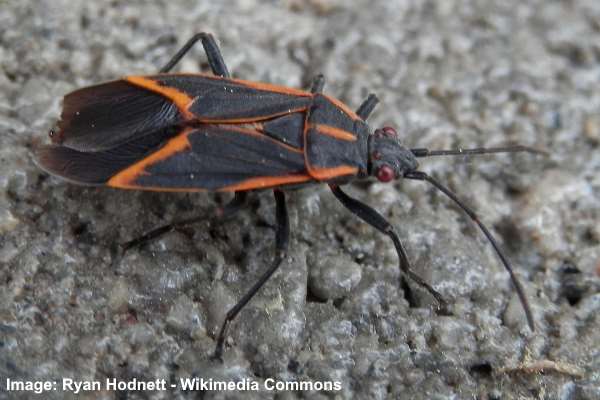
Boxelder bugs have a flat black body with orange markings
Boxelder bugs are common bugs with orange markings that are found in homes. The creepy crawlies are identified by their oval to tear-shaped flattened blackish bodies with bright orange lines on their back. Like all insects, these black and orange bugs have six legs and a pair of antennae.
The boxelder bug measures 0.5” (12.7 mm) long. You can identify these bugs in the house by the orange ‘X’ shape on their backs. Although the pesky bug gets into homes and is a nuisance when they fly around the room, they are relatively harmless. However, they may leave red stains on fabrics if you squash them.
The best way to eliminate boxelder bugs from your home is to use a vacuum. All you need is the long hose attachment and suck up as many of the orange bugs as you can.
But suppose you commonly get boxelder bugs in your home. In that case, you should seal all cracks and crevices on your exterior walls. It’s also a good idea to install insect screens to stop them from flying in through the windows. Because boxelder bugs feed on boxelder trees and silver maples, removing those trees can also help prevent bug infestations.
Small orange bug identification
Boxelder bugs are identified by their black wing cover with orange markings.
Asian Lady Beetle (Harmonia axyridis)
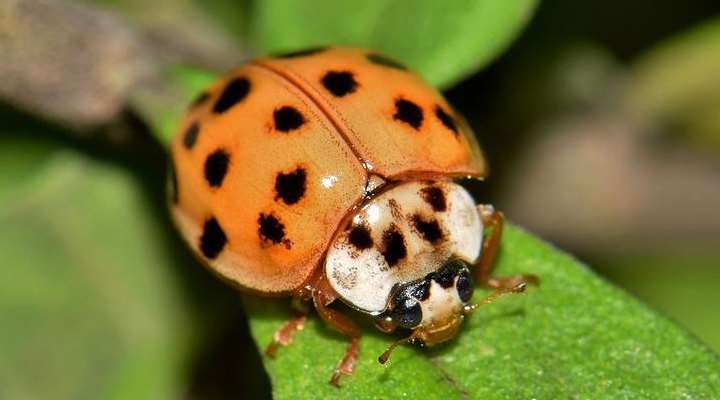
The Asian harlequin lady beetle has rounded orange body with black spots, however there are color variations and some lack spots
Asian ladybugs are orange-colored insects with black spots on rounded wing covers. These lady beetles are relatively large compared to native ladybugs. The orange bugs measure 0.21” to 0.33” (5.5 – 8.5 mm) long. They are also identified by their white “W” or “M” shaped marking on their thorax.
Although called a “bug,” these orange insects are not bugs in the order Hemiptera. Instead, they are an invasive species of winged flying beetle.
Asian lady beetles are helpful for controlling aphid populations. However, the orange beetles can become a pest if they enter homes in the fall. They fly or crawl around rooms and land on furniture, walls, and windows. The orange beetles can also bite if they land on your skin.
Using insect light traps or a vacuum cleaner is the best way to eliminate Asian beetles from your house. But, like getting rid of other orange-colored bugs, it’s best not to crush them because they emit a horrible stench and leave behind a yellowish stain.
Small orange bug identification
Asian lady beetles are orange-colored insects with domed elytra (wing covers) covered in tiny black spots. You can distinguish an Asian ladybug from native species by their larger size and distinctive white mark just behind their head.
Small Orange Bugs With Hard Shell
Some bugs with orange coloration have hard shells. These orange bugs are the Colorado potato beetle, orange stink bug, and the rare hibiscus harlequin bug. Here is information on identifying features of these insects.
Orange Colorado Potato Beetle (Leptinotarsa decemlineata)
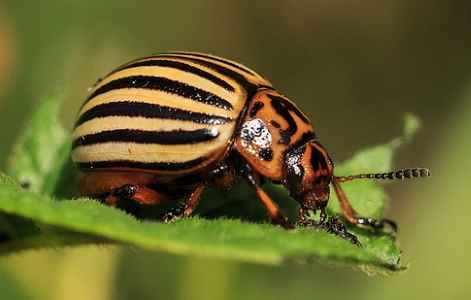
The Colorado potato beetle has black and light orange stripes along its rounded small body
The Colorado potato beetle is a hard-shelled insect with pale orange and black stripes and an orange thorax and head with black markings. These orange-striped beetles have a distinctive domed shape and an oval body. The orange and black “bugs” measure 0.24” to 0.43” (6 – 11 mm).
Despite their small size, the black and orange striped beetle can do extensive damage to potato crops. However, they can also decimate eggplants, tomatoes, peppers, ground cherry, and other nightshade crops.
Sometimes, the best way to prevent extensive Colorado potato beetle damage is to hand-pick the critters and drop them into soapy water. Or you could encourage beneficial insects that feed on Colorado beetle eggs. One of these is a species of ground beetle called Lebia grandis.
Small orange bug identification
Orange and black striped Colorado potato beetles are easy to recognize due to their distinctive stripes along their rounded elytra. They also have a flattened orange and black head and clavate-shaped antennae.
Orange Stink Bug (Musgraveia sulciventris)

Orange stink bugs can be easily identified by their orange oval flat body with a black dot and thin black margin
Also called the bronze orange bug, the orange stink bug is a sizable pesky insect. It’s identified by an orangey-pink broadly oval shape with a distinctive black spot in the center and a slender black margin. These plant-eating bugs develop brilliant orange colors as they mature. However, the adult beetles turn almost jet-black by late spring and summer.
Orange stink bugs grow up to 1” (25 mm) long. A feature of this orange-reddish bug is the malodorous stench it emits when threatened. This trait is common to all types of stink bugs. But you don’t want to get too close, as it can spray the irritating liquid up to 2 ft. (0.6 m) away.
These bronze orange bugs infest citrus trees and can do significant damage.
Small orange bug identification
The orange stink bug is easily identified due to its orange body with a solitary black dot in the center.
Hibiscus Harlequin Bug (Tectocoris diophthalmus)
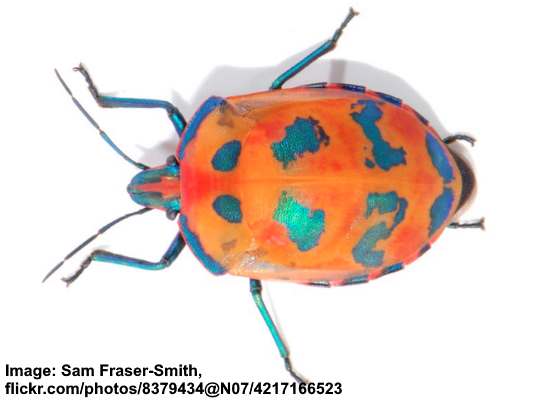
The hibiscus harlequin bug has an oval orange flat body with dark iridescent spots
The hibiscus harlequin bug is a brightly colored orange insect with iridescent green patches on a shield-shaped body. Its attractive coloration means the bugs also have metallic bluish-green legs and antennae and a small blue and orange head. These fascinating orange bugs measure 0.78” (20 mm) long.
Belonging to the bug order Hemiptera, the hibiscus harlequin bug uses its mouthpiece to pierce tender plant tissue and suck the sap from young shoots. The blue-spotted orange bugs feed on cotton, mallow, and bottlebrush plants.
Small orange bug identification
The hibiscus harlequin bug is easily identifiable due to its vibrant orange body with irregular iridescent patches on its back. Also, its metallic-colored legs give this orange bug an exotic appearance.
Related articles:
